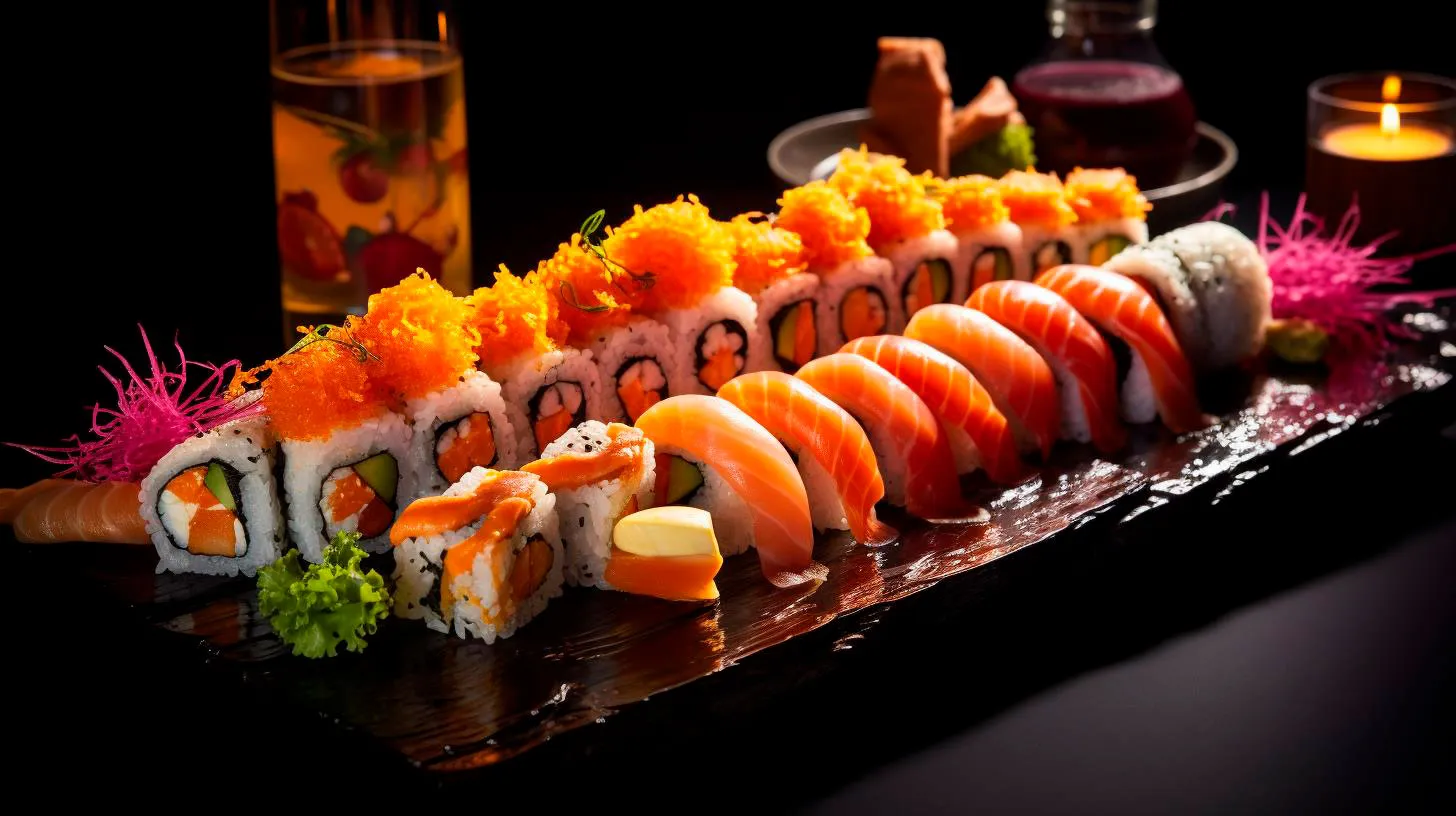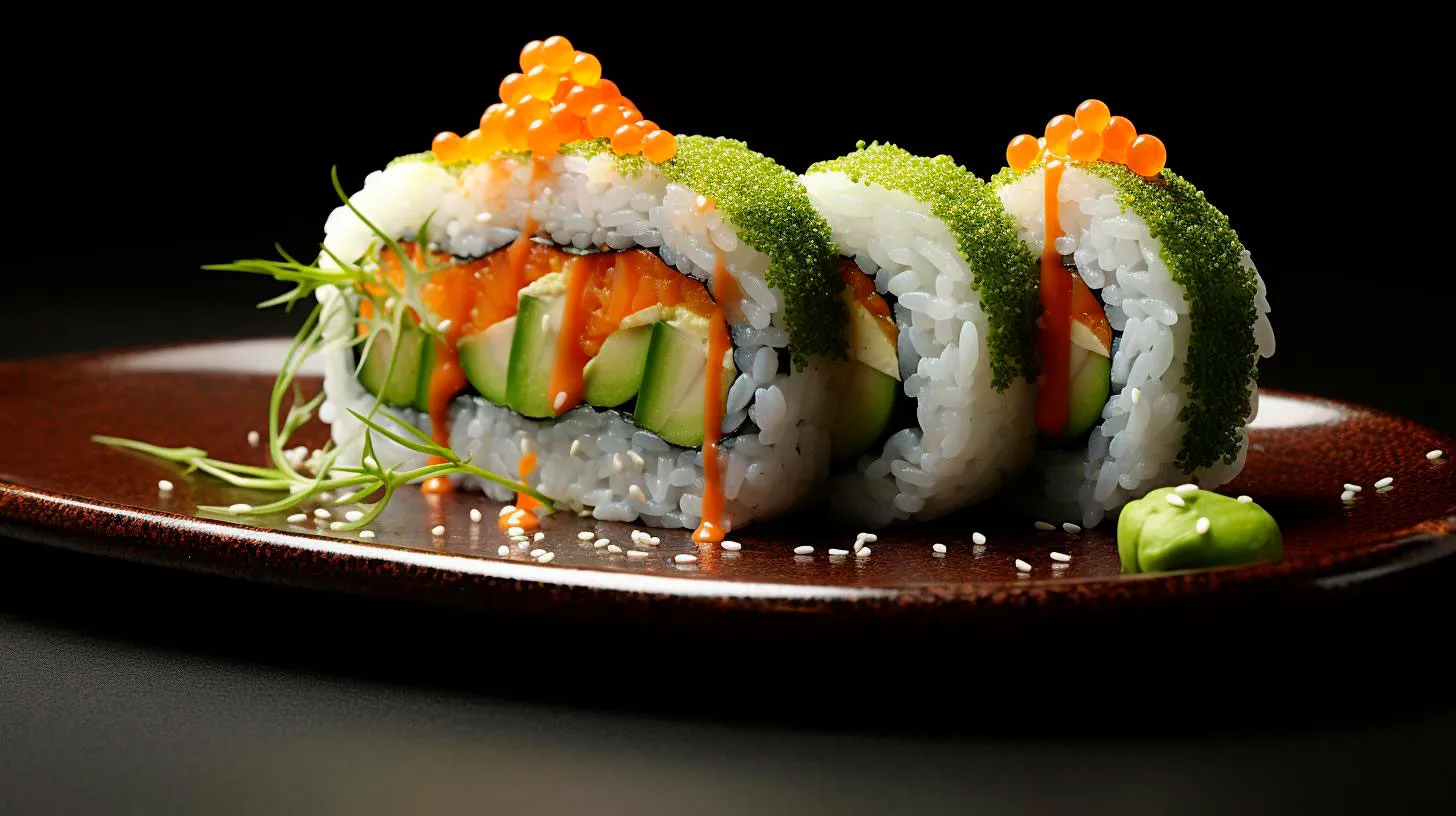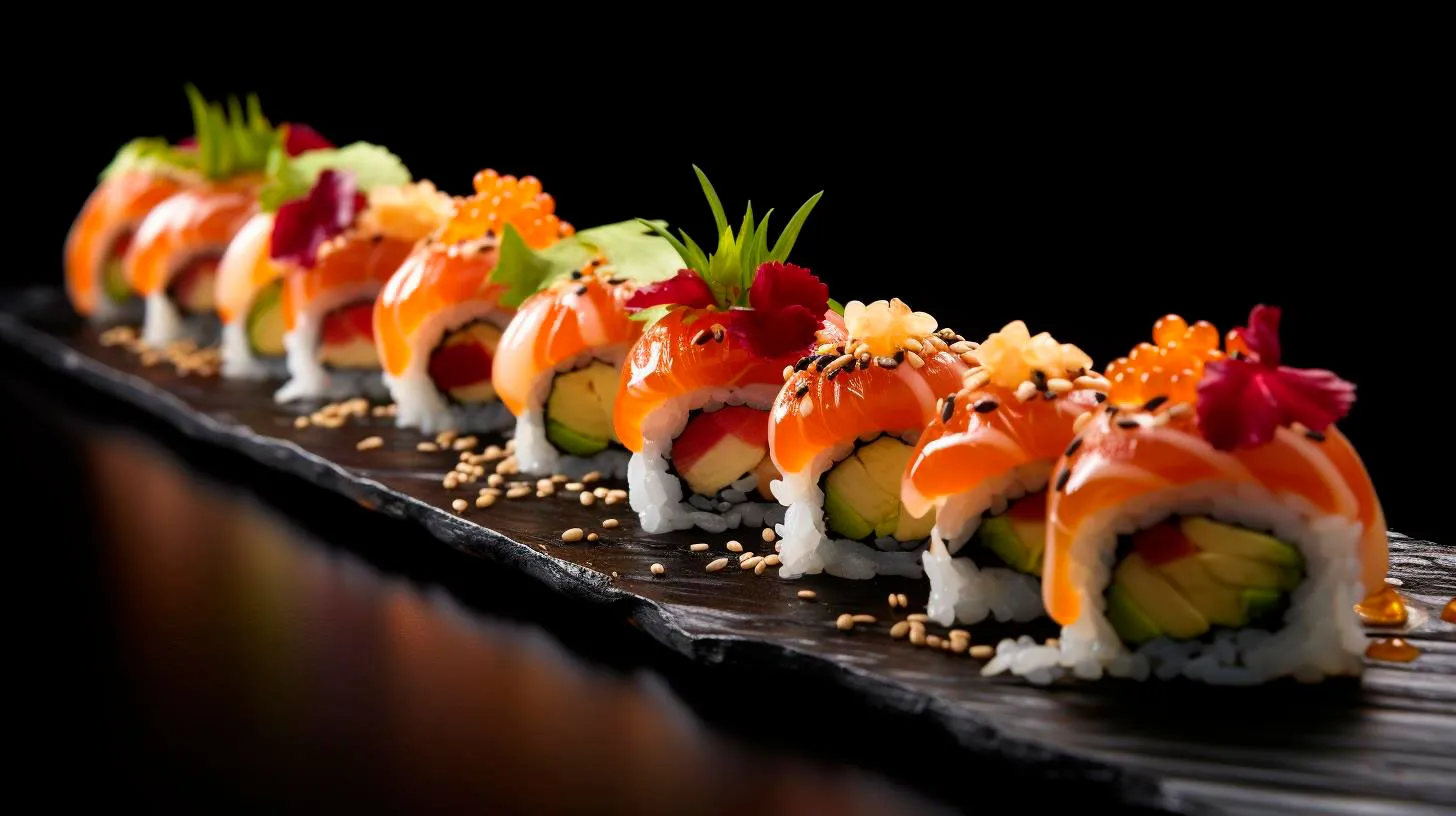Resolving Sushi Knife Rust Problems
Rust not only affects the knife’s functionality but also poses health risks if it comes into contact with the sushi. In this article, we will explore ways to resolve sushi knife rust problems, ensuring that your knives stay in top shape and your sushi remains safe for consumption.
The Dangers of Rust on Sushi Knives
Rust on sushi knives can lead to serious consequences if not addressed promptly. It alters the knife’s edge, making it dull and significantly reducing its cutting ability. Dull knives can result in sloppy cuts, ruining the aesthetic presentation of sushi rolls. More importantly, rust particles can contaminate the sushi, compromising its quality and posing health risks to consumers.
Here are a few key dangers associated with rust on sushi knives:
- Contamination: Rust particles can contaminate the food, leading to harmful effects on human health, including food poisoning, stomachaches, and potential infections.
- Loss of Sharpness: Rust weakens the blade, and an unhealthy cutting edge can not provide precise and clean cuts required for sushi preparation.
- Reduction in Durability: Rust weakens the structure of a knife, making it more susceptible to chipping or breaking during use.
Preventing Rust on Sushi Knives
Prevention is the key to ensuring the longevity and usability of your sushi knives. By following these best practices, you can significantly reduce the risk of rust formation:
Proper Knife Storage
Storing your sushi knives correctly goes a long way in preventing rust. Avoid leaving your knives lying around in drawers or kitchen counters where they can be exposed to moisture. Consider investing in a knife block or a magnetic strip to securely store your knives.
Regular Cleaning and Drying
After each use, thoroughly clean your sushi knives with warm water and mild detergent. Avoid using abrasive cleaners or scrub brushes that could damage the knife’s finish. Once cleaned, make sure to dry the knives completely, ensuring no moisture remains on the blades.
Applying a Protective Coating
Consider applying a thin layer of food-safe mineral oil on the blade to create a protective barrier against moisture. This coating helps to inhibit the formation of rust and prolongs the lifespan of your sushi knives. Remember to wipe off any excess oil before using the knife again.
Avoid Dishwasher Usage
While it may be tempting to toss your sushi knife into the dishwasher for convenient cleaning, it is best to avoid it. The harsh detergents and high heat in dishwashers can damage the knife’s blade and handle, increasing the risk of rust formation.
Resolving Existing Rust Problems
If you discover rust on your sushi knife, don’t panic. You can take several steps to remove the rust and restore your knife’s functionality:
Using Lemon Juice or Vinegar
Lemon juice or vinegar’s acidic properties can effectively dissolve rust. Soak the affected area in either of the two for a few minutes and then gently scrub away the rust using a soft cloth or sponge. Rinse the knife thoroughly, and dry it completely before storing.
Using Baking Soda Paste
Mixing baking soda with water to form a paste creates a natural abrasive cleaner. Apply the paste to the rusted area and gently scrub it using a soft cloth or sponge. Rinse the knife thoroughly and dry it completely.
Professional Knife Restoration
If the rust problem persists or if the knife has significant damage, it is advisable to seek professional help. Professional knife restorers have the expertise and tools necessary to remove rust and restore the knife to its former glory.
Key Takeaways
- Preventing rust on sushi knives is vital to ensure their functionality and maintain food safety.
- Proper knife storage, regular cleaning and drying, applying a protective coating, and avoiding dishwasher usage are effective preventive measures.
- Removing rust from sushi knives can be done using lemon juice or vinegar, baking soda paste, or by seeking professional knife restoration.
- Regular maintenance and care will keep your sushi knives in optimal condition, enabling you to prepare beautiful and safe sushi for years to come.
By following these steps and incorporating proper maintenance practices into your routine, you can bid farewell to rust problems and enjoy the art of sushi-making with confidence.
Troubleshooting Dull Sushi Knife Blades
Common Causes of Dull Sushi Knife Blades
Before we delve into the troubleshooting techniques, let’s take a look at some common causes that lead to dull sushi knife blades:
- Regular Usage: When a sushi knife is used regularly, it is bound to lose its sharpness over time. The constant contact with cutting boards and food can gradually wear down the blade.
- Incorrect Handling: Mishandling your sushi knife can also contribute to its dullness. Applying excessive force, using incorrect cutting techniques, or using the wrong knife for specific tasks can all impact the blade’s sharpness.
- Poor Maintenance: Neglecting proper maintenance and care of your sushi knife can accelerate the dulling process. Failing to regularly hone, sharpen, and store the knife correctly can cause the blade to lose its edge.
Troubleshooting Techniques
To ensure your sushi knife remains sharp and effective, try implementing the following troubleshooting techniques:
1. Regular Honing
Honing your sushi knife is a crucial step in maintaining its sharpness. The honing process can help realign the microscopic teeth on the blade, maximizing its cutting performance and extending its overall lifespan. Remember to hone your knife before each use for the best results.
2. Proper Cutting Technique
Adopting the correct cutting technique can significantly reduce the dulling rate of your sushi knife. To avoid exerting excessive pressure on the blade, use a slicing motion, allowing the knife to glide effortlessly through the ingredients. Additionally, using a cutting board made of soft materials like wood or plastic can minimize blade wear.
3. Sharpening at the Right Time
When your sushi knife shows signs of dullness despite regular honing, it may be time for sharpening. Sharpening should be performed periodically to restore the blade’s sharpness. Invest in high-quality sharpening stones or consider professional sharpening services for optimal results.
4. Proper Storage
The way you store your sushi knife can make a significant difference in its longevity. Avoid overcrowded knife blocks or drawers where blades may come into contact with other utensils, leading to nicks and dulling. Opt for a knife sheath or a magnetic strip to keep your knife safely stored and protected.
Advantages of Maintaining a Sharp Sushi Knife Blade
Understanding the advantages of maintaining a sharp sushi knife can motivate you to implement proper troubleshooting techniques:
- Precision: A sharp sushi knife allows you to achieve precise cuts and thin slices, enhancing the presentation of your sushi.
- Efficiency: With a sharp blade, you can effortlessly glide through ingredients, reducing prep time and increasing overall efficiency.
- Flavor: When slicing through delicate fish and other ingredients, a sharp blade minimizes tearing and crushing, preserving the flavors and textures of the sushi.
- Safety: A dull sushi knife requires more force to cut, increasing the chances of slips and accidents. Keeping your knife sharp helps ensure safer food preparation.
Key Takeaways
Now that you are equipped with troubleshooting techniques to maintain the sharpness of your sushi knife, here are the key takeaways to remember:
- Regular honing keeps the blade aligned and enhances cutting performance.
- Adopt proper cutting techniques to minimize blade wear and tear.
- Sharpen your knife periodically to restore its sharpness.
- Invest in proper storage to protect the blade and prevent dulling.
Remember, a sharp sushi knife not only enhances your sushi-making experience but also elevates the quality of your culinary creations. Take care of your sushi knife, and it will reward you with precision, efficiency, and a delightful sushi feast.
Fixing Loose Sushi Knife Handles
In this article, we will discuss how to fix loose sushi knife handles and ensure that your knife remains in top shape for seamless preparation of exquisite sushi dishes.
Signs of a Loose Sushi Knife Handle
Before delving into the solutions for fixing a loose knife handle, it’s crucial to identify the signs that indicate a loose handle. Here are a few indicators:
- The handle wiggles or moves while using the knife.
- You notice a visible gap between the blade and the handle.
- There is a clicking sound when you grip the handle tightly.
- The knife feels unbalanced and unstable.
If you notice any of these signs, it’s time to address the issue promptly to prevent further damage to your knife or possible injuries.
Reasons Behind Loose Sushi Knife Handles
Understanding the reasons behind loose sushi knife handles can help prevent future occurrences. So, what causes a knife handle to become loose? Let’s explore:
- Prolonged usage: Over time, the constant use of your sushi knife can cause the handle to loosen.
- Poor craftsmanship: Cheaply made or poorly constructed knives are more prone to handle issues.
- Moisture and temperature changes: Exposure to water or extreme temperature fluctuations can affect the handle’s integrity.
By being aware of these causes, you can take proactive measures to maintain your knife properly and avoid loose handles in the future.
Fixing a Loose Sushi Knife Handle
Now that we’ve established the importance of addressing a loose sushi knife handle let’s explore some effective solutions:
1. Using Epoxy Resin
Epoxy resin is an efficient adhesive that can help secure a loose sushi knife handle. Here’s how you can use it:
- Thoroughly clean and dry the knife handle for better adhesion.
- Apply a small amount of epoxy resin to the area where the handle and blade meet.
- Press the handle firmly against the blade, making sure it aligns properly.
- Leave the blade undisturbed for the recommended curing time specified by the epoxy resin manufacturer.
Using epoxy resin can effectively bond the handle to the blade, strengthening the connection and eliminating any wobbling.
2. Replacing Handle Rivets
If your sushi knife handle has rivets, they may be the cause of the loose handle. Replacing the rivets can restore stability. Follow these steps:
- Remove the old rivets using a small drill bit or a specialized rivet removal tool.
- Carefully insert new rivets into the handle holes.
- Use a riveting tool or hammer to secure the new rivets in place.
Replacing worn-out rivets can reinforce the handle and prevent future loosening.
3. Professional Repair
For complex handle issues or if you feel unsure about handling the repair yourself, it is best to seek help from a professional knife repair service. These experts specialize in repairing and restoring damaged knife handles, ensuring their longevity and durability. They have the necessary tools and expertise to fix the issue effectively, giving you peace of mind.
Key Takeaways
When it comes to fixing a loose sushi knife handle, identifying the signs, understanding the causes, and addressing the issue promptly are essential. Here are the key takeaways from this article:
- Signs of a loose sushi knife handle include movement, gaps, clicking sounds, and imbalance.
- Causes of loose handles include prolonged usage, poor craftsmanship, and moisture/temperature changes.
- Solutions include using epoxy resin, replacing handle rivets, or seeking professional repair.
By following these guidelines, you can ensure that your sushi knife remains in optimal condition, providing you with precise and safe cutting experiences for many delightful sushi creations.
Solving Sushi Knife Maintenance Mistakes
However, many individuals make common maintenance mistakes that can lead to decreased knife performance, increased risk of accidents, and a shorter lifespan for their knives. In this article, we will discuss some of these mistakes and provide practical solutions to help you maintain your sushi knives like a pro.
Mistake 1: Improper Cleaning
One of the most common mistakes people make when it comes to sushi knife maintenance is improper cleaning. Simply rinsing the blade with water is not enough; it is crucial to remove any leftover food particles, oils, and residue from the blade.
Solution:
- Use a gentle dish soap specifically designed for knives to clean the blade thoroughly.
- Avoid using abrasive scrubbers or harsh chemicals that can damage the blade’s surface.
- Always dry your knife immediately after cleaning to prevent rust from forming.
Mistake 2: Inadequate Sharpening
A dull sushi knife can make precision cuts difficult and increase the risk of accidents. However, many people make mistakes when it comes to sharpening their knives, either sharpening too often or not enough.
Solution:
- Invest in a high-quality knife sharpening stone or a professional sharpener.
- Follow the instructions carefully to ensure the proper sharpening angle.
- Regularly test the sharpness of the blade by gently slicing through a piece of paper.
Mistake 3: Storing Incorrectly
Improper storage can lead to unnecessary wear and tear on your sushi knives. Storing them in the wrong way can also pose a safety risk, potentially leading to accidental cuts.
Solution:
- Invest in a knife block or a magnetic strip to store your knives safely.
- Ensure that the knives are dry before storing them to prevent rust.
- Avoid storing knives in a crowded drawer where they can bump against other utensils.
Mistake 4: Using the Wrong Cutting Board
The surface you use to cut your sushi ingredients can significantly impact the longevity of your knives. Using the wrong type of cutting board can dull the blade quickly or even damage it.
Solution:
- Choose a cutting board made from bamboo or high-quality wood that is gentle on the blade.
- Avoid using glass or ceramic cutting boards, as they can quickly dull the knife.
- Regularly sanitize the cutting board to prevent any bacteria buildup.
Mistake 5: Neglecting Professional Maintenance
While regular maintenance is essential, neglecting professional care for your sushi knives can result in long-term damage and decreased performance.
Solution:
- Consider taking your knives to a professional for routine maintenance and inspection.
- Professional sharpening and honing can help extend the lifespan of your knives and ensure optimal performance.
- Follow any specific care instructions provided by the manufacturer.
Key Takeaways
Maintaining your sushi knives properly is crucial for achieving excellent sushi preparation results. By avoiding common mistakes such as improper cleaning, inadequate sharpening, storing incorrectly, using the wrong cutting board, and neglecting professional maintenance, you can extend the lifespan of your knives, improve performance, and ensure safety in the kitchen.
Remember, cleaning the knife properly with a gentle dish soap, sharpening it at the right frequency, storing it safely, choosing the right cutting board material, and seeking professional maintenance when necessary are the key steps to solve sushi knife maintenance mistakes. By implementing these solutions, you can elevate your sushi preparation skills and enjoy the art of sushi making with ease.



